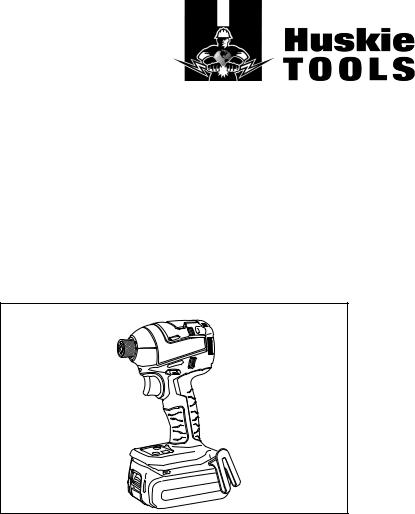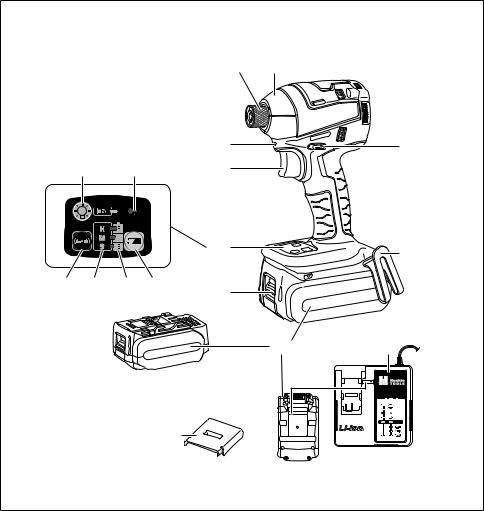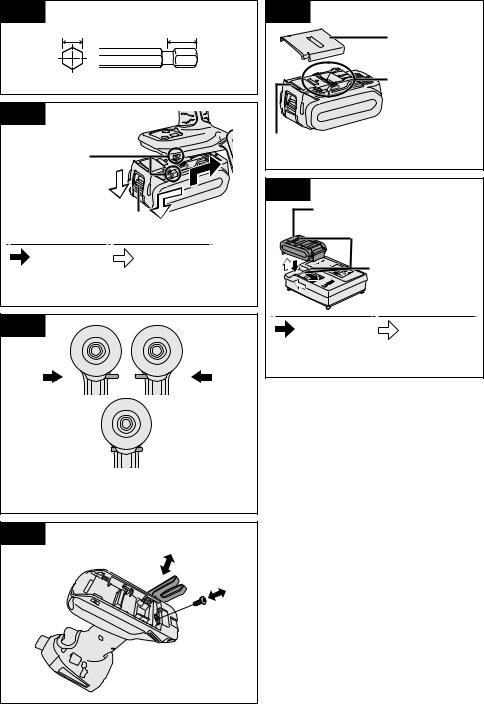Panasonic htp-cid Operation Manual

Cordless Impact Driver
Destornillador de impacto inalámbrico
Operating Instructions
Manual de instrucciones
Model No: HTP-CID
IMPORTANT
This manual contains safety information. Read manual completely before first using this product and save this manual for future use.
IMPORTANTE
Este manual contiene información de seguridad. Lea completamente este manual antes de utilizar por primera vez este producto, y guárdelo para poder consultarlo en el futuro.

ndex/ |
Indice |
|
|
|
English: |
Page |
9 |
Español: Página |
22 |
FUNCTIONAL DESCRIPTION
DESCRIPCIÓN FUNCIONAL
(A) (B)
|
|
|
(O) |
(C) |
(L) |
(M) |
|
(N) |
|
|
|
|
(G) |
(D) |
|
|
|
|
|
(K) (J) |
(I) |
(H) |
(F) |
|
|
|
|
|
|
|
|
|
(E) |
(P) |
|
|
|
|
(Q) |
|
|
|
(R) |
|
|
6.35 mm hex quick connect chuck |
|
Nose protector |
|
(A) |
Mandril hexagonal de conexión rápida |
(B) |
Protector del morro |
|
|
de 6,35 mm |
|
|
|
(C) |
Forward/Reverse lever |
(D) |
Belt hook |
|
Palanca de avance/inversión |
Gancho del cinturón |
|||
|
|
|||
(E) |
Battery pack |
(F) |
Battery pack release button |
|
Batería |
Botón de liberación de batería |
|||
|
|
|||
(G) |
Control panel |
(H) |
Battery level button |
|
Panel de controle |
Botón de nivel de la batería |
|||
|
|
|||
|
Battery level indicator |
|
Impact power mode display |
|
(I) |
Indicador de nivel de la batería |
(J) |
Indicación de modo de potencia de |
|
|
|
|
impacto |
|
(K) |
Impact power mode button |
(L) |
Light button |
|
Botón de modo de potencia de impacto |
Botón de la luz |
|||
|
|
|||
|
Overheat warning lamp (motor/battery) |
|
Variable speed control trigger |
|
(M) |
Luz de advertencia de sobrecalenta- |
(N) |
Disparador del control de velocided |
|
|
miento (motor/batería) |
|
variable |
|
(O) |
LED light |
(P) |
Battery charger |
|
Luz indicadora |
Cargador de batería |
|||
|
|
|||
(Q) |
Alignment marks |
(R) |
Pack cover |
|
Marcas de alineación |
Cubierta de batería |
|||
|
|
NOTE: Not all battery packs display the alignment mark (Q).
NOTA: No todas las baterías muestran la marca de alineamiento (Q).

[Fig.1] |
|
6.35 mm (1/4″) |
9.5 mm (3/8″) |
[Fig.2] |
|
Alignment marks |
|
Marcas de alineación |
|
|
Button |
|
Botón |
Attaching |
Removing |
Acoplamiento |
Desacoplamiento |
[Fig.3] |
|
Forward |
Reverse |
normal |
Marcha atrás |
Avance |
Switch lock
Bloqueo delinterruptor
[Fig.5]
Pack cover
Cubierta de batería
Terminals
Bornes
Terminales
Label (red or yellow)
Etiqueta (roja o amarilla)
[Fig.6] |
|
Battery pack release button |
|
Botón de liberación de batería |
|
|
Alignment marks |
|
Marcas de alineación |
Attaching |
Removing |
Acoplamiento |
Desacoplamiento |
[Fig.4] |

This tool, as a complete unit with a battery pack, satisfies appropriate IP Degrees of Protection based on the IEC regulations.
Definition of IP code
IP5X: Ingress of dust is not totally prevented, but dust shall not penetrate in a quantity to interfere with satisfactory operation of the tool or to impair safety (In case that the talcum powder under 75 μm intrudes inside the tool).
IPX6: Water projected in powerful jets against the tool from any direction shall have no harmful effects (In case that, with a nozzle of 12.5 mm inner diameter, approximately 100 L/min of normal temperature water is injected to the tool for 3 minutes from 3 meter distance).
LIMITED WARRANTY
The rating of IP56 qualifies this tool for the minimum impact of water or dust, but not for the assurance of performance in such conditions. See Safety and Operating
Instructions for further details for proper operation.
I. General Power Tool Safety Warnings
 WARNING! Read all safety warnings and all instructions. Failure to follow the warnings and instructions may result in electric shock, fire and/or serious injury.
WARNING! Read all safety warnings and all instructions. Failure to follow the warnings and instructions may result in electric shock, fire and/or serious injury.
Save all warnings and instructions for future reference.The term ²power tool² in the warnings refers to your mainsoperated (corded) power tool or battery-operated (cordless) power tool.
Work Area Safety
1)Keep work area clean and well lit.
Cluttered or dark areas invite accidents.
2)Do not operate power tools in explosive atmospheres, such as in the presence of flammable liquids,
Power tools create sparks which may ignite the dust or fumes.
3)Keep children and bystanders away while operating a power tool.
Distractions can cause you to lose control.
Electrical Safety
1)Power tool plugs must match the outlet. Never modify the plug in any way. Do not use any adapter plugs with earthed (grounded) power tools.
Unmodified plugs and matching outlets will reduce risk of electric shock.
2)Avoid body contact with earthed or grounded surfaces such as pipes, radiators, ranges and refrigerators.
There is an increased risk of electric shock if your body is earthed or grounded.
3)Do not expose power tools to rain or wet conditions.
Water entering a power tool will increase the risk of electric shock.
4)Do not abuse the cord. Never use the cord for carrying, pulling or unplugging the power tool. Keep cord away from heat, oil, sharp edges or moving parts.
Damaged or entangled cords increase the risk of electric shock.
5)When operating a power tool outdoors, use an extension cord suitable for outdoor use.
Use of a cord suitable for outdoor use reduces the risk of electric shock.
6)If operating a power tool in a damp location is unavoidable, use a residual current device (RCD) protected supply.
Use of RCD reduces the risk of electrical shock.
Personal Safety
1)Stay alert, watch what you are doing and use common sense when operating a power tool. Do not use a power tool while you are tired or under the influence of drugs, alcohol or medication.
A moment of inattention while operating power tools may result in personal injury.
2)Use personal protective equipment. Always wear eye protection.
Protective equipment such as dust mask, non-skid safety shoes, hard hat, or hearing protection
used for appropriate conditions will reduce personal injuries.
3)Prevent unintentional starting.
A moment of inattention while operating power tools may result in serious personal injury.
4)Remove any adjusting key or wrench before turning the power tool on.
A wrench or a key left attached to a rotating part of the power tool may result in personal
injury.
5)Do not overreach. Keep proper footing and balance at all times.
This enables better control of the power tool in unexpected situations.
6)Dress properly. Do not wear loose clothing or jewelry. Keep your hair, clothing and gloves away from moving parts.
Loose clothes, jewelry or long hair can be caught in moving parts.
7)If devices are provided for the connection of dust extraction and collection facilities, ensure these are connected and properly used.
Use of dust collection can reduce dust-related hazards.
Power Tool Use and Care
1)Do not force the power tool. Use the correct power tool for your application.
The correct power tool will do the job better and safer at the rate for which it was designed.
2)Do not use the power tool if the switch does not turn it on and off.
Any power tool that cannot be controlled with the switch is dangerous and must be repaired.
3)Disconnect the plug from the power source and/or the battery pack from the power tool before making any adjustments, changing accessories, or storing power tools.
Such preventive safety measures reduce the risk of starting the power tool accidentally.
4)Store idle power tools out of the reach of children and do not allow persons unfamiliar with the power tool or these instructions to operate the power tool.
Power tools are dangerous in the hands of untrained users.
5)Maintain power tools. Check for misalignment or binding of moving parts, breakage of parts and any other condition that may affect the power tools operation. If damaged, have the power tool repaired before use.
Many accidents are caused by poorly maintained power tools.
6)Keep cutting tools sharp and clean.
Properly maintained cutting tools with sharp cutting edges are less likely to bind and are easier to control.
7)Use the power tool, accessories and tool bits etc. in accordance with these instructions, taking into account the working conditions and the work to be performed.
Use of the power tool for operations different from those intended could result in a hazardous situation.
